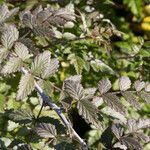Shrubs 1.5–3 m tall. Branchlets brownish to reddish brown, glabrous, glaucous, with sparse, curved prickles. Leaves imparipinnate, 7–9-foliolate, rarely 5-foliolate; petiole 3–5 cm, petiolule of terminal leaflet 1–2 cm, lateral leaflets subsessile, petiolule and rachis glabrous, with sparse, curved minute prickles; stipules linear or linear-lanceolate, 5–7 mm, glabrous; blade of leaflets oblong-lanceolate or ovate-lanceolate, terminal leaflet sometimes nearly rhombic and minutely lobed, 5–10 × 1.5–4(–5) cm, abaxially gray tomentose, adaxially glabrous or sparsely pilose, base broadly cuneate or rounded, margin irregularly coarsely serrate or incised-doubly serrate, usually lobed on terminal leaflet, apex acuminate. Inflorescences terminal or axillary, terminal ones cymose panicles, 10–16(–18) cm, lateral ones often subracemes, rarely subcorymbose; rachis and pedicels glabrous; bracts linear, 2–5 mm, glabrous. Pedicel somewhat reddish when young, 7–12 mm, slender. Flowers to 1 cm in diam. Calyx abaxially glabrous; sepals erect at anthesis, reflexed in fruit, ovate-lanceolate, 5–8 × 2–4 mm, margin gray tomentose and entire, apex long acuminate. Petals pink, suborbicular or obovate, 5–7 × 4–5 mm, margin premorse or coarsely serrate above middle, base shortly clawed. Stamens many, slightly shorter than petals; filaments linear, broader toward base. Pistils slightly shorter than stamens; ovary soft hairy; styles glabrous. Aggregate fruit purplish black, subglobose, less than 1 cm in diam., slightly pubescent or subglabrous; pyrenes shallowly rugose. Fl. May–Jul, fr. Aug–Sep.
More
An arching deciduous shrub. It grows 2.2-2.7 m high and 1.8-2.5 m wide. The stems are purplish and prickly. They are covered with a white bloom. The leaves are dark green and have 9 egg shaped leaflets. They are furry white underneath. The flowers are purple. The fruit are purplish-black. They are less than 1 cm across and slightly hairy.
Can be grown by cuttings or seedlings. Seeds needs stratification.

